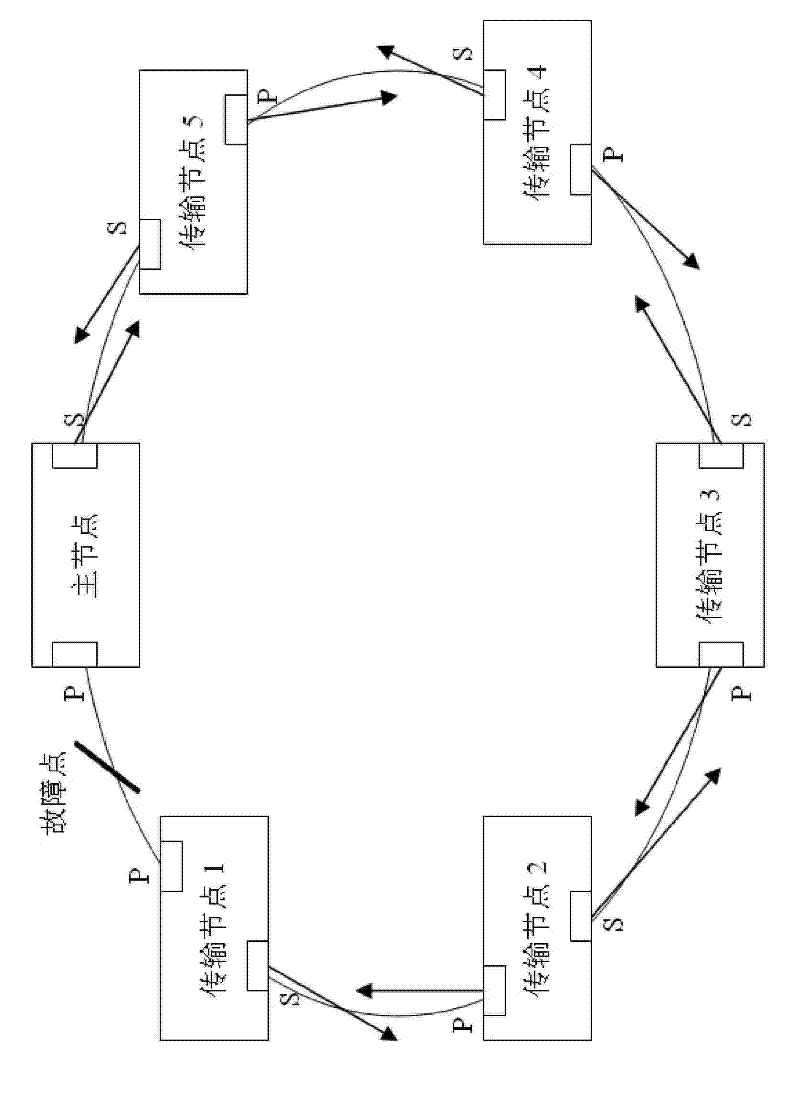Method for accelerating switching during Ethernet automatic protection switching failure
A technology of Ethernet ring network in case of failure, which is applied in the field of Ethernet technology and Ethernet ring network EAPS protocol, which can solve the problems of increasing the complexity of the protocol, and achieve the effect of improving the speed of failover and reducing the probability of refreshing
- Summary
- Abstract
- Description
- Claims
- Application Information
AI Technical Summary
Problems solved by technology
Method used
Image
Examples
Embodiment 1
[0022] like figure 2 , when the physical line between transit node 2 and transit node 3 fails, both transit node 2 and transit node 3 detect the fault, and transit node 2 and transit node 3 respectively perform the following operations: generate a LINK_DOWN message and a RING_DOWN_FLUSH_FDB message Then send the LINK_DOWN message to the master node, and send the RING_DOWN_FLUSH_FDB message to other transmission nodes; and refresh its own MAC entry.
[0023] After receiving the first LINK_DOWN message, the master node modifies the spanning tree state of the secondary port to the forwarding state, refreshes the MAC entry, and sends the message to transit nodes 1, 2, 3, 4, and 5 on the ring through the primary port and secondary port. RING_DOWN_FLUSH_FDB message.
[0024] After the transfer node receives the LINK_DOWN message sent to the master node, it does not process the message and forwards it directly.
[0025] Transit node 1 should first receive the RING_DOWN_FLUSH_FDB m...
Embodiment 2
[0027] like image 3 , when the line between the master node and transit node 1 fails, transit node 1 detects the fault, generates a LINK_DOWN message and a RING_DOWN_FLUSH_FDB message, then sends the LINK_DOWN message to the master node, and sends the RING_DOWN_FLUSH_FDB message to transit node 2 , 3, 4, and 5; and refresh its own MAC entries. For the primary node, no matter whether it detects the line failure of its port P by itself or judges the line failure of its port P by receiving a LINK_DOWN message, it first sets the spanning tree state of its secondary port to the forwardable state, and generates The RING_DOWN_FLUSH_FDB message is sent from the secondary port S to transit nodes 5, 4, 3, 2 and 1. Since the faulty transit node 1 also sends the RING_DOWN_FLUSH message, it can also reduce the probability that the MAC entries of some transit nodes cannot be refreshed in time due to the loss of the RING_DOWN_FLUSH_FDB message.
Embodiment 3
[0029] like Figure 4 , when the line between the master node and transit node 5 fails, transit node 5 detects the fault, generates a LINK_DOWN message and a RING_DOWN_FLUSH_FDB message, then sends the LINK_DOWN message to the master node, and sends the RING_DOWN_FLUSH_FDB message to transit node 4 , 3, 2, and 1; and refresh its own MAC entries. For the master node, whether it detects the line fault of its secondary port S by itself or judges the line fault of its secondary port S by receiving a LINK_DOWN message, it must generate a RING_DOWN_FLUSH_FDB message and send it from the primary port P to the transmission Nodes 1, 2, 3, 4 and 5. Since the faulty transit node 5 also sends the RING_DOWN_FLUSH message, it can reduce the probability that the MAC entries of some transit nodes cannot be refreshed in time due to the loss of the RING_DOWN_FLUSH_FDB message.
PUM
 Login to View More
Login to View More Abstract
Description
Claims
Application Information
 Login to View More
Login to View More - R&D
- Intellectual Property
- Life Sciences
- Materials
- Tech Scout
- Unparalleled Data Quality
- Higher Quality Content
- 60% Fewer Hallucinations
Browse by: Latest US Patents, China's latest patents, Technical Efficacy Thesaurus, Application Domain, Technology Topic, Popular Technical Reports.
© 2025 PatSnap. All rights reserved.Legal|Privacy policy|Modern Slavery Act Transparency Statement|Sitemap|About US| Contact US: help@patsnap.com



